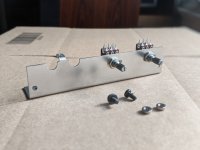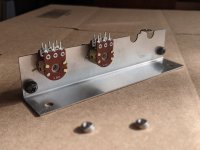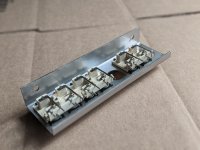I managed to identify two yummie candy looking Phillips Tantalums in the Contour HF section thanks to macrophotography, LOL. Getting Vishay replacements.

Now, this morning, I have two 470pF caps to identify in the Input Stage section. Could they be Polystyrene?

Now, this morning, I have two 470pF caps to identify in the Input Stage section. Could they be Polystyrene?
The 100nf caps you have on your list are polyester, not polypropylene. I'd probably use some Wima MKP-2 if a 5mm lead spacing will fit. I noticed some REL RTE series that are black and look like the ones on the board (kinda), but the largest value of those is 0.01uf, so 10 times smaller. Polystyrene are hard to come by anymore.
I have updated the components list. Caps are Polypropylene, except the electrolytics in the PSU and two Tantals in the Contour HF section.
And I still have that unknown 470pF cap pictured above. ;-)
Cost of components to populate a KUBE 200 shall end up at around $50 including about $8 worth of resistors. It could be less if cheaping out on some capacitors by not buying name brands.
 , excluding the three 10K Dual potentiometers w/ center, 12 and 18 push button switches, rear phono connectors, and 5 pin 240° DIN connector
, excluding the three 10K Dual potentiometers w/ center, 12 and 18 push button switches, rear phono connectors, and 5 pin 240° DIN connector
Picture below is of KUBE 200 with Issue 2 PCB and the one being reproduced.

And I still have that unknown 470pF cap pictured above. ;-)
Cost of components to populate a KUBE 200 shall end up at around $50 including about $8 worth of resistors. It could be less if cheaping out on some capacitors by not buying name brands.
Picture below is of KUBE 200 with Issue 2 PCB and the one being reproduced.
Last edited:
And below is the KUBE 200 prototype I got from ex KEF engineer SpeakerGuru. It was designed for testing a new sub/satellite system in the early 1990s.
The board is Issue 2. Once I have measured the resistors from the BEC (because it sounds damn good on my 107/2s), I will redo the whole board and clean it up.
One can notice that in the BEC, resistors were soldered in serie, most likely for testing until a correct combination is found. Trim pots have been removed. Many values of caps are different. I believe I only need to clean up the BEC, Input stage and Variable gain sections. I will make this KUBE a hybrid KUBE with 107/2 Bass Extension Correction and KUBE 200 Contours.

The board is Issue 2. Once I have measured the resistors from the BEC (because it sounds damn good on my 107/2s), I will redo the whole board and clean it up.
One can notice that in the BEC, resistors were soldered in serie, most likely for testing until a correct combination is found. Trim pots have been removed. Many values of caps are different. I believe I only need to clean up the BEC, Input stage and Variable gain sections. I will make this KUBE a hybrid KUBE with 107/2 Bass Extension Correction and KUBE 200 Contours.
Thanks for pointing me to the cheaper 100nF WIMA MKP2D031001F00JSSD Metalized Polypropylene capacitors. I have added it on the list as an alternative to Vishnay's MKP1837410161F Metalized Polypropylene capacitors.The 100nf caps you have on your list are polyester, not polypropylene. I'd probably use some Wima MKP-2 if a 5mm lead spacing will fit. I noticed some REL RTE series that are black and look like the ones on the board (kinda), but the largest value of those is 0.01uf, so 10 times smaller. Polystyrene are hard to come by anymore.
It seems that, after hours of rsearch, that Poiystyrene capacitors are now difficult to source except from New Old Stock. ;-)
Front and rear stainless backets came out perfect and are 1:1 repros with a few improvements














Attachments
Picked up 20 faceplates fresh from the CNC shop. Then brought them for black anodizing. The foillowing step will be laser etching the scripts




Front and rear stainless backets came out perfect and are 1:1 repros with a few improvements
Sorry I didn't see this thread earlier. I would not use that type of IC socket as they loosen up on pin contact quite easily. I would use machine pin sockets such as these Mill-Max ones: 110-93-308-41-001000
The trouble with machined pin IC sockets is they bend IC pins much more often (*) than the cheap sort (which are reliable in my experience for a small number of insertion cycles). A ZIF socket is needed for frequent insertion/removal anyway, so I don't think the machined sort are worth it.
(*) The issue is much more accurate alignment of pins is needed for insertion, and in some circumstances on PCBs you don't have good visibility and thats when pins get bent.
(*) The issue is much more accurate alignment of pins is needed for insertion, and in some circumstances on PCBs you don't have good visibility and thats when pins get bent.
- Home
- Design & Build
- Electronic Design
- KEF KUBE 200 and 107/2 Hybrid clones



